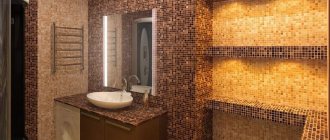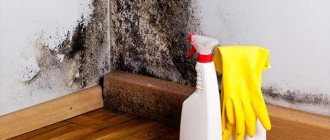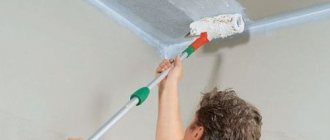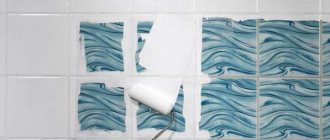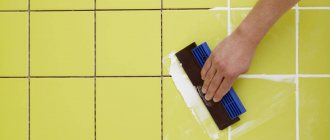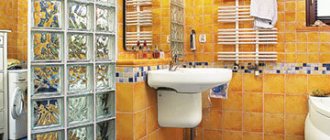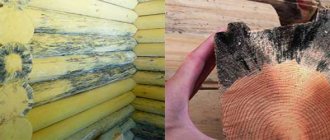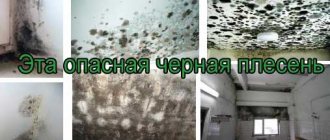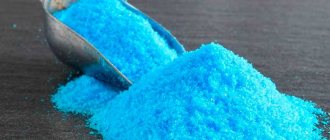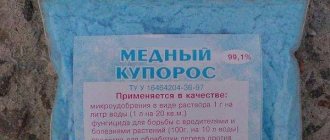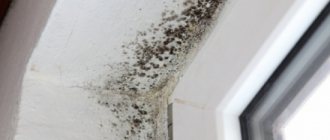A clean bathroom is important not only for its aesthetic appeal, but also for the health of the household. Unfortunately, high humidity can cause mold to appear in tile joints or on the ceiling. If mold has appeared in the bathroom, do not rush to start repairs, it is quite possible to get rid of it, there are many methods. Here you will learn in detail about each and easily cope with such a nuisance as mold. Believe me, your bathroom can still regain its original appearance!
The main thing about the problem
Scientists have found that mold appeared about 200 million years ago. The fungus managed to survive drought and the ice age. Traces of mold are found even in areas with high background radiation, where other organisms cannot survive.
Causes of mold
There are several reasons why mold may appear in the bathroom. The main ones:
- High humidity levels. The bathroom contains water pipes, a sink, a bathtub, a washing machine and other items related to moisture. Therefore, the humidity here is constantly high. Such an environment creates favorable conditions for the reproduction and formation of fungal organisms.
- Predominance of artificial lighting. Most often, modern bathrooms do not have windows, so the light in them is maintained artificially. Experts have long proven that natural light suppresses the viability of fungus, so its absence provokes mold growth.
- Heat. Hot water is constantly used in this room. In addition, a dryer can be installed in it. Increased air temperature is the optimal condition for fungal life forms.
- Gaps, cracks, chips. In the bathroom you can find many gaps where moisture accumulates inside. In most cases, mold marks appear under the bathtub, PVC panels, in tile joints or behind the clothes washing machine.
- Air stagnation. The lack of window openings and insufficiently efficient ventilation are additional factors contributing to the development of mold.
Signs of fungus
Mold can be recognized by the following signs, depending on its type:
- gray and black: dark spots on the surface, in the early stages the mold has no color, so it is difficult to notice;
- white: whitish coating having a velvety and fibrous structure;
- green and blue: traces have a heterogeneous structure;
- red or pink: fluffy surface, light matte (soapy) coating.
Places where mold stains occur
Mold spots can appear in different areas. Depending on the variety, mold can be localized in the following places:
- gray and black: rooms with high humidity;
- white: nutritious foods, moistened coverings, soil in pots for indoor flowers;
- green and blue: natural finishing materials (including wood), soil for plants, food, brick;
- red or pink: rotting products, some types of indoor plants.
What harm can mold cause?
Mold can cause significant damage to finishes by destroying materials. In addition, its spores can have an adverse effect on the human body. Fungus can cause the following problems:
- rashes on the skin;
- cough;
- feeling of lethargy and weakness;
- chronic rhinitis;
- baldness;
- eczema;
- bronchial asthma;
- severe intoxication;
- rheumatic pain;
- deterioration of the digestive system;
- chronic headache;
- conjunctivitis;
- hemorrhages of internal organs.
Causes of fungus and harm to the body
Unlike fungi that are beneficial to humans, which are used to sour milk and create medicines, there are also harmful types. Mold can settle in industrial premises, in living rooms and bedrooms, in the kitchen, but most often it can be seen in the bathroom or other rooms with high humidity.
The immediate cause of the appearance of fungus lies in dampness. Risk factors:
- indoor humidity more than 60%,
- violation of the ventilation regime, rare ventilation of the room,
- the presence of walls with poor vapor permeability,
- errors during installation of the ventilation system,
- excessive coolness, lack of heating (for example, on the balcony),
- presence of leaking plumbing.
Often the fungus is found in end apartments, where it is colder than in housing with a different location. In some apartments, mold deposits are detected after the installation of plastic windows, since the microclimate in the room changes and air circulation is disrupted.
How to find fungus on walls or ceilings? You need to pay attention to black, green, yellow spots, less often they are gray-brown, pink. Some people think that such stains are just dirt, but you shouldn’t put up with it or remove it with regular water. Mold elements are responsible for the production of aflatoxins, which cause intoxication of the body and over time can provoke cancer.
Yellow mold is considered the most dangerous and poisonous, but other fungi also produce mycotoxins, which reduce immunity and performance and can cause the following diseases:
- rhinitis, otitis, sinusitis,
- allergies, urticaria, diathesis in children,
- bronchial asthma,
- headache,
- damage to the heart and internal organs,
- skin diseases,
- diarrhea, nausea,
- stomatitis,
- conjunctivitis.
The unpleasant sight that is a fungus can be seen almost everywhere where there is high humidity. Microorganisms can invade brick, concrete walls, ceilings or floors; they thrive on putty, plaster and especially wood.
It is the most difficult to remove mold from wood, since the growth rate of microorganisms is faster, and wooden surfaces retain moisture more strongly. Furniture and wooden wall coverings are the most “popular” substrates on which mold settles.
In second place at the risk of infection are loose gypsum walls and bases on which there is a thick layer of putty. Mold also appears on brick and concrete, but removal is easier.
Basic means of combating mold on tiles
If mold has appeared in the bathroom on the seams of the tiles, experts will tell you how to get rid of it. However, there are also folk remedies that can solve this problem.
Vinegar
9% table vinegar should be poured into a vessel with a spray bottle. The volume of liquid is selected depending on the extent of the lesion.
The mold localization areas should be treated generously with the mixture, and then wait until it dries. Then you need to remove the remaining fungus with a rag, a thick sponge or a brush with hard bristles.
If mold traces appear in hard-to-reach places, then they need to be sprinkled with soda and poured with acetic acid. The method is applicable to any horizontal surfaces.
Hydrogen peroxide
The product is applied to mold-affected areas. For convenience, you can use a napkin thoroughly soaked in hydrogen peroxide.
After treatment, you should not enter the room for 1-1.5 hours. Then the surfaces need to be wiped with a cloth or brush.
When using this product to combat fungus, you need to take into account that it has a whitening effect. For example, colored decorative elements may become unsightly after the procedure.
Ammonia
The composition must be diluted with water in a 1:1 ratio. After this, the mixture should be placed in a vessel with a spray bottle and sprayed onto problem areas.
After 120-130 minutes, the ammonia is washed off and the surface is wiped dry.
Soda
In 0.25 liters of clean water you need to dissolve 1 tbsp. l. baking soda. Soak a sponge in the resulting mixture, or place the mixture in a vessel with a spray bottle.
After the soda solution has dried, it should be washed off and the treated surfaces should be wiped dry.
To eliminate the musty smell, you can place an open package of baking soda powder under the bathtub. In addition, during the cleaning process, you can add 3-4 tablespoons of soda per 1 bucket to the water for washing tiles and floors.
Furacilin
Furacilin tablets are used to combat mold. You need to take 20 pcs. and grind them to a powdery state.
Then you need to pour 250-300 ml of water into a vessel with a spray bottle, add the prepared powder there and screw it on.
The bottle must be shaken until the drug is completely dissolved. The composition is sprayed onto moldy surfaces. After half an hour or an hour, the treated areas should be wiped with a dry cloth.
Furacilin is used not only to get rid of mold, but also to prevent its formation. To do this, you need to perform such processing monthly.
Copper sulfate
A solution of copper sulfate is used to remove mold in the toilet and bathroom directly from the tiles and from the seams. The toxicity of vitriol should be a warning to take safety precautions.
The instructions for use state that the product is mixed with water in a ratio of 100 to 10, that is, 100 g of the substance is added to 10 liters of water.
The tiled surface is treated with a solution in which a sponge is soaked. Vitriol is applied to the seams with a toothbrush or brush. In places where there is a strong accumulation of blackness, the product is passed over repeatedly. Then wait several hours and wash the base. The air in the room is ventilated.
Boric acid
0.5 kg of boric acid must be dissolved in 10 liters of clean water. To increase the effectiveness of the product, you can add 2 tbsp to its composition. l. vinegar and 0.5 g of borax.
The affected areas are treated with a spray bottle or a hard sponge. After 2-3 hours, the mixture is washed off with water, and the surface is wiped free of moisture.
To consolidate the achieved effect, it is recommended to apply the product again after 1-1.5 weeks. For the purpose of prevention, it is advisable to apply the treatment every month.
Creosote
This substance allows you to remove even old fungus. But you need to keep in mind that creosote is aggressive and can damage wood, so you need to wear gloves and a respirator when working with it. The composition is diluted in alcohol or oil. The prepared solution is applied to the seams and affected areas and left for 20-30 minutes. Then the surface is wiped dry.
Premium mold repellents
Mellerud mold remover with chlorine
A universal and effective product with a wide spectrum of action: it destroys all types of mold. Fights germs and unpleasant odors. The main ingredient is chlorine. Suitable for walls and ceilings, stone and wood masonry, tiles and grout. Can even be used in swimming pools, basements and utility rooms.
Mellerud Chlorine Mold Remover Ranks Best Wall Mold Remover for 2021
A distinctive feature is the quick effect. Just apply it for 20 minutes and then wash it off. Treatment with this product gives a radiant cleanliness and fills the room with a fresh aroma. Sold in 0.5 liter spray bottles.
Advantages:
- quick effect;
- convenient use;
- odor control;
- reasonable price for its properties.
Flaws:
- No.
Spray Cif “Power of Nature”
An environmentally friendly product with natural composition. The active ingredients are acetic acid and fruit organic acids.
Cif Power of Nature in the ranking of the best products for removing mold on walls in 2021
Works great against mold, stains, soap scum and lime deposits. The formula is gentle on surfaces, including acrylic. Does not cause allergies and is safe. The drug is packaged in 0.5 liter bottles with a convenient spray.
Advantages:
- efficiency;
- reasonable price;
- natural ingredients;
- Quick effect.
Flaws:
- No.
Kenaz "Anti-mold"
Quickly defeats pink and black mold, fights dirt and germs, and eliminates unpleasant odors. Prevents the recurrence of fungus.
Mechanical methods for removing mold in the bathroom
Steam cleaning
If the mold colonies between the tiles in the bathroom are not very large, and the infection is just beginning to spread, then you can get by with little money. It is necessary to understand that both mold and fungi are microorganisms that will not survive at high temperatures. If you steam them, they will die.
Therefore, there is an option to remove mold in the bathroom using steam. To do this, you need to purchase a special device, which is called a steam cleaner.
Most often in stores you can find this device from. A small, hand-held device that is inexpensive and energy-intensive.
It is plugged into the outlet after first pouring some water into a special internal tank. Saturated steam with a high temperature comes out through the nozzle, and it must be directed to the tiles into the seams.
Grouting joints
The second mechanical method belongs to the “cardinal” category. It is usually used only if fungus and mold have affected the grout between ceramic tiles to a sufficiently large depth. Such an infection cannot be removed by any means. There is only one thing left to do - remove the grout itself and apply new one in its place.
That is, it turns out that it will be necessary to carry out a small renovation of the bathroom. To remove grout, you need to prepare a tool that looks like a knife with a sharp blade. There are many options: a spatula, a screwdriver, a sharpened nail. There is a ready-made device that is used specifically for removing grout. It is sold in construction stores in the “Tools” department.
Attention! Dismantling the grout must be done very carefully. The important thing here is not to damage the ceramic tile itself. It is recommended to wet the fugue in sections before starting the process. It is also necessary to clean the seams between the tiles in sections.
Next, everything is the same as according to the technology for applying the grouting material.
- Take a rubber spatula in your hands and apply a fugue between the tiles.
- Application is done with slight pressure. In this case, the tool must be held relative to the lined plane at an angle of 90°.
- After the grout has dried, remove any remaining material with a clean, dry rag or sponge.
It will be even better if, after removing the fugue, you treat the seams with a cleaning agent. This is a guarantee that mold will be removed completely and irrevocably.
Treatment before painting
How and with what should I treat the wall against mold and mildew before painting? This question worries many people, especially those who have high humidity in their apartment or house. If fungus or mold has formed, then these microorganisms must be carefully removed with a spatula along with a layer of plaster. At the same time, the wall surface is cleaned from dust and dirt, and remnants of the old coating.
Surfaces affected by mold and mildew should be thoroughly treated with an antiseptic several times, and the walls should be coated with a primer, as this will ensure better adhesion of the paint. The base is then leveled using putty, and a layer of plaster is applied to severely damaged areas. After leveling the surface of the wall, it is covered with paint.
Household chemicals
It should be noted that both vinegar and soda can be classified as chemical methods for cleaning mold on tile joints. But these are not special preparations, so they are most often classified as folk remedies. As for the chemical method, it is clear that household chemicals are used in cleaning processes.
There are two options here:
- Products containing chlorine.
- Special cleaning products made specifically for removing mold on tiles.
The first group includes household chemicals such as “Belizna”, “Domestos” and so on. Essentially, these are powders that contain chlorine (an active chemical element). They are applied to the tiled surface using a wet sponge, and after removing the mold, they are washed with water. That's the whole operation.
Attention! Household cleaners not only clean the grout between tiles, but also disinfect the entire tile surface.
The second group includes products produced by manufacturers specifically for cleaning ceramic tiles and specifically against mold, fungi and bacteria. The assortment on the market is huge, there is plenty to choose from. It is impossible to say that there are some strong and high-quality drugs and some less effective ones. Everything is learned through comparison, especially price comparison. But, as practice shows, anti-mold in the optimal ratio of quality and price is available on the market. Therefore, you need to try all the drugs and find your remedy.
What means do you prefer?
Folk Household chemicals
Main types of fungi
Mold is microorganisms, a class of lower fungi, whose spores float in the air, settle, infect surfaces, and grow to huge masses. As soon as the spores find themselves in favorable conditions, the fungi are activated and begin to multiply. Mold is omnivorous and ubiquitous. Malicious microflora affects any area and destroys (destroys) most construction and finishing materials. Scientific mycologists recommend paying attention to the four most harmful types of fungal scourge:
- common mold. Fungal colonies affect stone, brick, concrete, and plastered walls. When developing, fungi form microdots of gray, black or brown color. In advanced cases, infected areas become covered with entire fields of mold.
- blue fungus terrorizes wooden structures. Blue stain disfigures and destroys the tree
- White and brown rot appears only on wood. Wood masses decompose from the inside, lose their strength and exterior
- actinomycetes are bacteria that form branching mycelium (an intermediate form between fungi and algae). The attack spoils the appearance, destroys, causes softening of materials
Industrial drugs
Treatment with such preparations allows you to completely clean all surfaces in the room, including areas under sanitary and hygienic devices. However, the main task is to eliminate the causes of mold growth.
Before embarking on cleaning activities, you must study and strictly adhere to the rules for pre-treatment of surfaces. First, severe contamination is removed, then the area is dried using a hair dryer. It is not recommended to include water during the treatment procedure, because the air regime must be kept dry. The seams between the tile elements are also thoroughly treated with antifungal agents.
Note! When carrying out work on treating surfaces with special chemicals, always follow the rules of personal safety. The face is covered with a protective mask, hands with rubber gloves. This is the only way to avoid harm from the use of active chemical compounds, contact with which in a closed space can hardly be avoided.
List of industrially produced anti-mold preparations:
- Renogal;
- PS 50;
- Titan Fungcide;
- impregnation "Snezhka".
Many people neglect to purchase these specialized antifungal drugs, preferring more budget-friendly options (for example, copper sulfate). However, excessive enthusiasm for the latter can be costly for the homeowner. Since the use of copper sulfate, getting rid of one type of fungus, can cause the development of another. In this connection, the most preferable option is to choose a modern industrial product.
Techniques on different surfaces
There are surfaces that require special approach and attention.
Joints between tiles
If the fungus appears in the joints of the tiles, then to remove it you can use the following instructions:
- First, you need to identify the area where the mold is located. In this case, it is recommended to mark the most extensive lesions with a bright felt-tip pen so as not to miss them during processing.
- Use a wire brush or sandpaper to remove the dark grout. It is advisable to additionally remove the coating near moldy traces, because it may contain fungal spores.
- Apply white to clean areas and heat the surface with a hair dryer or soldering iron.
- Then you need to make a grout mixture and treat its required areas. After the composition has dried, remove excess with a sponge.
- At the final stage, you need to treat the space between the tiles with a transparent varnish composition.
We also recommend watching - How to update the seams between tiles in the bathroom
Tile
To treat tiles you need to dilute 1 tbsp. l. tea tree extract in 0.5 liters of clean water. The prepared mixture should be placed in a spray bottle and shake the bottle.
The solution should be sprayed onto the tile surface and left for 5-6 hours. After this, wipe the surface with a cloth.
The extract obtained from the tea tree is not only an effective antiseptic, but also an allergenic substance. Therefore, before using it, you should find out how other family members will react to it.
Sealant
If mold appears on silicone-based sealant, you can use a mixture of 1 part boric acid, 2 parts hydrogen peroxide and 4 parts vinegar.
In the finished solution, you need to wet the sponge and treat the surface. After 20-30 minutes, the composition must be washed off and the sealant wiped off moisture.
After such treatment, the room must be ventilated for 5-6 hours.
Ceiling
It is extremely difficult to eliminate fungus on such a surface. In addition, mold can penetrate deeper into concrete through paint and whitewash.
In this case, repair experts recommend using special antiseptic impregnations, which are sold in construction supply stores.
Before applying the solution, you need to treat the ceiling surface with warm water from a spray bottle. This is necessary so that mold cannot spread throughout the space.
The product is sprayed onto previously cleaned areas and 50-60 beyond them. After the coating has dried, you should re-spray the antiseptic composition. Then the surface is cleaned with a metal scraper or a brush with hard bristles.
To achieve maximum effect, it is recommended to repeat the treatment 2-3 times. At the final stage, the ceiling must be puttied again and the necessary finishing work must be done.
Prevention measures
Experts recommend installing a forced ventilation system in the bathroom.
To avoid problems associated with mold, it is advisable to follow the following preventive measures:
- It is necessary to ensure effective air circulation in the room. If this is not possible, then you will have to leave the door to the room open.
- Water pipes should be cleaned regularly to remove condensation.
- Plumbing equipment must be in good working order. Leaking taps often cause increased humidity. If there is a problem. It is better to immediately seek help from an experienced plumber.
- It is not advisable to dry washed clothes in the bathroom. This is best done in well-ventilated areas or on the balcony.
- The bathroom should be cleaned regularly. In this case, it is advisable to use fungicide compounds that can be used to destroy mold in its infancy.
- Repair work must be carried out correctly.
If you want to make adjustments to the interior design of the bathroom, then it is recommended to start the renovation by applying antiseptic solutions to all surfaces there.In addition, for finishing it is better to use special materials that contain antifungal substances.
When renovating a bathroom, you need to pay special attention to replacing utility lines. For example, experts have long noticed that in those rooms where copper pipes are installed, mold appears less frequently.
It is also necessary to take into account that you need to fight mold using a respirator and protective gloves. These products will help protect the respiratory system and skin from the effects of aggressive agents.
Harm to humans
Parasitic fungal microorganisms not only spoil construction and finishing surfaces, but also directly harm human health. Fungal spores enter the respiratory system, come into contact with the skin, and cause food poisoning. The negative consequences of aggressive microflora are extremely serious - toxins generated by mold colonies provoke:
- skin crises (dermatitis, eczema)
- respiratory system diseases (asthma, pneumonia)
- severe joint pathologies
- decreased vision (retinal detachment, conjunctivitis)
- collapse of the kidneys, liver, gastrointestinal tract
- problematic rashes on the genitals
Malicious microflora destroys the immune system, quietly weakens people, contributes to the development of diseases, and in extremely advanced cases leads to death.
